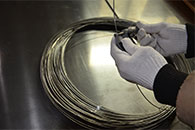Aug . 14, 2024 11:33 Back to list
CE Certified Coated Wire Mesh Manufacturing Facilities for High Quality and Durability in Production
CE Certification for Coated Wire Mesh Factories Ensuring Quality and Compliance
In today’s manufacturing landscape, especially in the wire mesh industry, quality assurance and compliance with international standards play crucial roles. One pivotal aspect that factories must focus on is obtaining CE certification for their coated wire mesh products. This certification not only signifies adherence to safety and performance standards set by the European Union but also enhances marketability, credibility, and competitiveness.
Understanding CE Certification
CE marking is a mandatory conformity mark for products sold within the European Economic Area (EEA). The letters 'CE' stand for 'Conformité Européenne,' which translates to European Conformity. This mark indicates that the product complies with EU legislation, thereby ensuring that it meets safety, health, and environmental protection requirements. For coated wire mesh manufacturers, obtaining CE certification is essential, as it assures customers and regulators that their products are of high quality and meet established standards.
Importance of Coated Wire Mesh
Coated wire mesh is widely used in various applications, including agriculture, construction, architecture, and industrial applications. Its ability to resist corrosion, provide structural support, and serve as a protective barrier makes it an important material in diverse sectors. However, the quality of coated wire mesh depends significantly on the manufacturing process and the materials used, making certification a vital factor for manufacturers.
The CE Certification Process for Coated Wire Mesh Factories
The process of obtaining CE certification for coated wire mesh involves several key steps. It begins with thorough product testing to ensure that the wire mesh complies with relevant standards, such as EN 10223 for welded wire mesh or EN 10218 for wire rope. Manufacturers may need to engage with third-party testing organizations or notified bodies that specialize in evaluating product compliance.
Next, the factory must prepare a technical file that documents the design, manufacturing processes, and quality control measures. This file is critical for demonstrating compliance with applicable directives, such as the Low Voltage Directive or the Directive on Personal Protective Equipment, depending on the intended use of the wire mesh.
ce certification coated wire mesh factories

Once the necessary documentation is compiled and testing is complete, manufacturers can proceed to affix the CE mark on their products
. This marking not only opens doors to the European market but also reflects a commitment to quality and safety for customers worldwide.Benefits of CE Certification
1. Market Access CE certification is often a prerequisite for selling products in the EU market. It allows manufacturers to broaden their customer base and enhance sales opportunities.
2. Quality Assurance The certification process compels manufacturers to improve their production methods, leading to higher quality products that satisfy customer expectations.
3. Consumer Trust Displaying the CE mark on coated wire mesh products enhances consumer confidence, as the mark is associated with reliability and safety.
4. Competitive Advantage In a crowded marketplace, having CE certification can differentiate a factory’s products from competitors, driving market share.
Conclusion
For coated wire mesh factories, obtaining CE certification is more than just a regulatory requirement; it is a pathway to ensuring product quality and safety. By committing to this certification process, manufacturers can not only comply with EU regulations but also gain significant advantages in the global marketplace. As the wire mesh industry continues to evolve, prioritizing compliance and quality assurance will be essential for long-term success. Investing in CE certification is an investment in the future, laying the groundwork for sustainability and growth in an ever-competitive environment.
share
-
CE Certified 250 Micron SS Mesh: Precision & Durability
NewsAug.15,2025
-
CE Certified 250 Micron Stainless Steel Mesh - Durable & Precise
NewsAug.14,2025
-
Precision CE Certified 250 Micron Stainless Steel Mesh
NewsAug.13,2025
-
CE Certified Metal Fine Mesh & Screen Fabric | Top Quality
NewsAug.12,2025
-
Premium CE Certified 250 Micron Stainless Steel Mesh
NewsAug.11,2025
-
CE Certified Stainless Steel Wire Mesh for Screen Printing
NewsAug.10,2025

